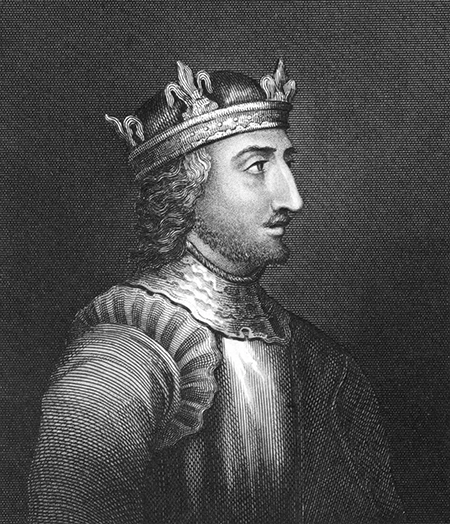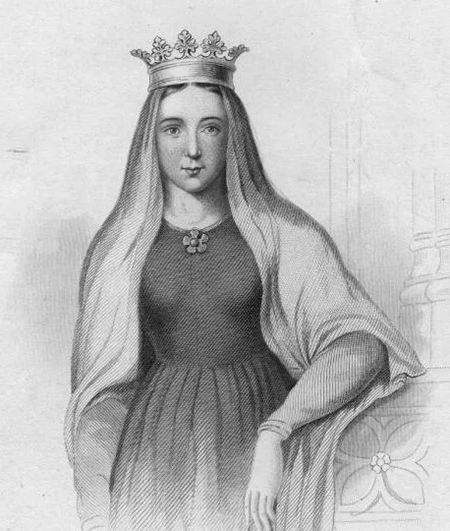



King Stephen – Quick Stats




Born: c. 1096 AD Blois, France
Challenges to Stephen’s Authority
Stephen faced significant challenges throughout his reign, including the erosion of royal authority and the rise of feudalism. The prolonged civil war allowed barons to consolidate their power, building private armies and fortifying castles, which undermined the king’s ability to govern effectively. Lawlessness and instability became rampant, earning this period a reputation for widespread suffering among the English populace.
Stephen faced significant challenges throughout his reign, including the erosion of royal authority and the rise of feudalism. The prolonged civil war allowed barons to consolidate their power, building private armies and fortifying castles, which undermined the king’s ability to govern effectively. Lawlessness and instability became rampant, earning this period a reputation for widespread suffering among the English populace.
King Stephen: The Unsteady Reign and the Anarchy That Shaped England
The Anarchy: Civil War with Empress Matilda
The defining feature of Stephen’s reign was the civil war known as The Anarchy, which erupted in 1139 when Empress Matilda launched her campaign to claim the throne. The conflict divided England, with some barons supporting Stephen and others backing Matilda. The situation was further complicated by Matilda’s marriage to Geoffrey Plantagenet, Count of Anjou, which brought additional military resources to her cause.
The defining feature of Stephen’s reign was the civil war known as The Anarchy, which erupted in 1139 when Empress Matilda launched her campaign to claim the throne. The conflict divided England, with some barons supporting Stephen and others backing Matilda. The situation was further complicated by Matilda’s marriage to Geoffrey Plantagenet, Count of Anjou, which brought additional military resources to her cause.
The conflict saw several key events, including the Battle of Lincoln in 1141, where Stephen was captured by Matilda’s forces. This victory allowed Matilda to briefly assert her authority and claim the title "Lady of the English." However, her inability to secure widespread support and her failure to be crowned queen in London ultimately weakened her position. Stephen was eventually released in a prisoner exchange and regained his throne, but the war continued in a grueling stalemate for much of the 1140s.
The Anarchy devastated England, as warring factions vied for control. The prolonged conflict eroded central authority and allowed opportunistic barons to seize power, leading to widespread lawlessness. Ordinary citizens bore the brunt of the chaos, suffering from raids, destruction, and economic instability. This period of prolonged unrest tested the resilience of the English monarchy and highlighted the fragility of feudal loyalties.
King Stephen of England, who ruled from 1135 to 1154, remains one of the most controversial and enigmatic figures in medieval English history. His reign, marred by civil war and political instability, is often referred to as "The Anarchy" due to the prolonged conflict over the English throne. Despite his efforts to maintain the kingdom, Stephen's legacy is largely defined by the chaos and uncertainty that characterized his time as king.
Died: c. 25th October 1154 AD Dover, Kent
Mother: Adela of Normandy
Daughter of William the conqueror)
Daughter of William the conqueror)
Father: Stephen, Count of Blois
Wife: Matilda of Boulogne 1125 - 1152 AD
Children: Eustace IV of Boulogne
William of Blois
One of Stephen’s major weaknesses was his inability to assert control over his barons. His tendency to grant concessions to powerful nobles in exchange for their loyalty often backfired, as it further fragmented the kingdom. Additionally, Stephen’s strained relationship with the Church, particularly with the influential Archbishop of Canterbury, added to his difficulties in maintaining authority.
Treaty of Winchester and Succession
The Treaty of Winchester, signed in November 1153, marked the end of The Anarchy and established a peaceful resolution to the succession crisis. Under the treaty, Stephen would remain king for the rest of his life, but he recognized Henry Plantagenet as his heir. This agreement ensured a smooth transition of power and brought a sense of stability to England after nearly two decades of conflict.
The Treaty of Winchester, signed in November 1153, marked the end of The Anarchy and established a peaceful resolution to the succession crisis. Under the treaty, Stephen would remain king for the rest of his life, but he recognized Henry Plantagenet as his heir. This agreement ensured a smooth transition of power and brought a sense of stability to England after nearly two decades of conflict.
Stephen died on October 25, 1154, and was succeeded by Henry Plantagenet, who became King Henry II. Despite the turmoil of Stephen’s reign, the treaty’s resolution laid the groundwork for the restoration of strong central authority under the Plantagenet dynasty.
Legacy
King Stephen’s reign is often viewed as a period of missed opportunities and failed leadership. While he was a personable and well-liked monarch, his inability to assert control over his barons and maintain stability ultimately defined his time on the throne. The Anarchy left a lasting impact on England, highlighting the dangers of weak central authority and the need for a clear line of succession.
King Stephen’s reign is often viewed as a period of missed opportunities and failed leadership. While he was a personable and well-liked monarch, his inability to assert control over his barons and maintain stability ultimately defined his time on the throne. The Anarchy left a lasting impact on England, highlighting the dangers of weak central authority and the need for a clear line of succession.
Despite the challenges he faced, Stephen’s reign serves as a pivotal chapter in English history. His struggles and eventual compromise paved the way for the reign of Henry II and the eventual consolidation of royal power. Stephen’s story is a reminder of the complexities of medieval politics and the enduring consequences of leadership during times of crisis. His reign, though turbulent, contributed to shaping the framework of English governance, providing important lessons for the generations of monarchs who followed.
Early Life and Background
Stephen was born around 1096 in Blois, France, as the third son of Stephen, Count of Blois, and Adela of Normandy, the daughter of William the Conqueror. As the grandson of the Conqueror, Stephen was a member of the Norman elite, closely tied to the English throne. His early years were marked by a strong education and the cultivation of a network of alliances that would later prove crucial in his bid for the crown.
Stephen was born around 1096 in Blois, France, as the third son of Stephen, Count of Blois, and Adela of Normandy, the daughter of William the Conqueror. As the grandson of the Conqueror, Stephen was a member of the Norman elite, closely tied to the English throne. His early years were marked by a strong education and the cultivation of a network of alliances that would later prove crucial in his bid for the crown.
Stephen also married Matilda of Boulogne in 1125, a politically advantageous union that brought him wealth, additional land, and the support of the influential County of Boulogne. Matilda proved to be a stalwart ally and partner, often stepping into leadership roles during critical moments of Stephen’s reign.
Successor : Henry II
Predecessor : Henry I
When Henry died, Stephen seized the opportunity, racing to London and securing the support of the Church and barons to claim the throne. He was crowned king on December 22, 1135, despite Matilda’s claims.
Family and Personal Life
Stephen’s marriage to Matilda of Boulogne was one of the few stable aspects of his reign. Matilda was a formidable and capable queen who played a key role in supporting her husband during The Anarchy. She managed to rally troops, negotiate alliances, and govern effectively in his absence. The couple had several children, including Eustace IV of Boulogne, who was named Stephen’s heir, and William of Blois.
Stephen’s marriage to Matilda of Boulogne was one of the few stable aspects of his reign. Matilda was a formidable and capable queen who played a key role in supporting her husband during The Anarchy. She managed to rally troops, negotiate alliances, and govern effectively in his absence. The couple had several children, including Eustace IV of Boulogne, who was named Stephen’s heir, and William of Blois.

Marie of Boulogne
In 1113, Stephen moved to the English court of his uncle, King Henry I, where he became a trusted member of the royal household. Henry I, impressed by Stephen’s loyalty and abilities, rewarded him with extensive landholdings and titles, including the County of Mortain.
Ascension to the Throne
Stephen's path to the throne began with the death of Henry I in 1135. Henry’s only legitimate son and heir, William Adelin, had died in the White Ship disaster of 1120, leaving the succession in doubt. Henry had named his daughter, Empress Matilda, as his heir, but her gender and unpopularity among the Anglo-Norman barons created resistance to her rule.
Stephen's path to the throne began with the death of Henry I in 1135. Henry’s only legitimate son and heir, William Adelin, had died in the White Ship disaster of 1120, leaving the succession in doubt. Henry had named his daughter, Empress Matilda, as his heir, but her gender and unpopularity among the Anglo-Norman barons created resistance to her rule.
Stephen’s quick coronation was aided by his charm, generosity, and promises to uphold justice and reform. However, his reign was soon undermined by his inability to maintain the loyalty of the barons and the Church. The initial goodwill he garnered began to wane as dissent grew over his perceived weakness and inconsistent governance.

Empress Matilda
Despite his challenges, Stephen exhibited remarkable resilience. He remained a charismatic and determined leader, rallying his supporters and maintaining their allegiance through personal charm and calculated diplomacy. However, his efforts to stabilize his reign often fell short, as the underlying tensions of feudal politics proved insurmountable.
Tragedy struck Stephen’s family in 1153 when his son Eustace died unexpectedly. This loss weakened Stephen’s position and forced him to negotiate with Matilda’s son, Henry Plantagenet, who had emerged as a strong contender for the throne. These negotiations culminated in the Treaty of Winchester later that year.


